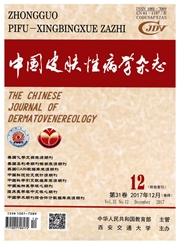

 中文摘要:
中文摘要:
目的观察犬小孢子菌脓癣株(1株)、头癣株(2株)和体癣株(2株)不同温度时的形态学区别。方法犬小孢子菌脓癣株、头癣株和体癣株分别在25℃和37℃行常规培养,观察菌落形态;小培养(钢圈法)观察镜下结构;25℃米饭培养,行透射电镜观察超微结构。结果菌落直径:3周后25℃头癣株达8.3cm,体癣株7.1cm,脓癣株1.9cm;37℃脓癣株为4.Ocm,头癣株5.4cm,体癣株5.Ocm。镜下结构:25℃时头癣株的菌丝、大分生孢子量最多,分隔最多(6~8个),37℃时脓癣株的菌丝、大小分生孢子略多于头癣株和体癣株。透射电镜:脓癣株孢子圆形、饱满,细胞壁厚,胞浆均匀,线粒体丰富,呈圆形、椭圆形。头癣株孢子梭状,细胞壁较厚,胞浆染色不均。体癣株孢子梭状,细胞壁厚,核仁大、清晰,线粒体模糊。结论脓癣株、头癣株、体癣株25℃和37℃生长时菌落直径及镜下结构有差异;透射电镜下脓癣株孢子较头癣株、体癣株饱满.细胞壁厚,细胞器明显可见,线粒体丰富。
 英文摘要:
英文摘要:
Objective To observe morphological differences of Microsporum canis ( M. canis) isolated from Kerion ( 1 strain), tinea capitis(2 strains) and tinea corporis (2 strains) at different temperatures. Methods The colony morphologies of routine culture were observed when all the M. canis strains ( 1 kerion strain, 2 tinea capitis strains and 2 tinea corporis strains) were cultured separately at 25% or 37℃ ; the structures of rims France culture were observed with microscope and the ultrastructures of these M. canis strains cultured on rice medium at 25℃ were observed with transmission electron microscope. Results Colony diameter: three weeks later, the colony diameters of tinea capitis strains, tinea corporis strains and kerion strain at 25℃ were 8.3cm, 7. lcm and 1.9cm, separately, and at 37℃ were 5.4cm, 5.0cm and 4.0cm, separately. Microscopic structure: the amounts of mycelia and conidia(containing 6 ~ 8 septations) of tinea capitis strains were largest at 25℃. The amounts of both mycelia and conidia of kerion strain were a little larger than the other two at 37℃. Morphology under transmission electron microscope: the kerion strain of M. canis showed that the spores were round with thick cell wall and clear organelle containing plentiful mitochondrion; the tinea capitis strains showed spores of shuttle shape with little thinner cell wall; and the tinea corporis strains showed shuttle shape with thick cell wall, and big nucleoli but unclear mitochondrion. Conclusion There are differences in colony diameter morphology and microscopic structures between kerion strain, tinea capitis strains and tinea corporis strains cultured at 25℃ or 37℃. Compared with tinea capitis strains and tinea corporis strains, the kerion strain spores have the thickest cell wall and obviously visible organelle with plentiful mitochondrion.
 同期刊论文项目
同期刊论文项目
 同项目期刊论文
同项目期刊论文
 期刊信息
期刊信息
